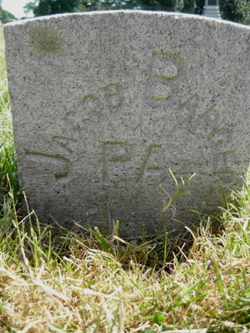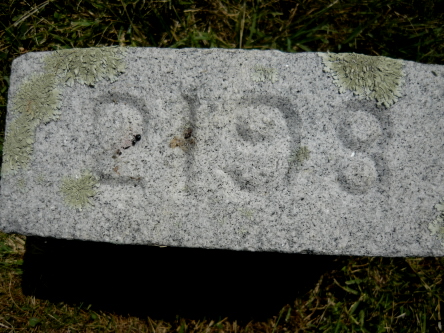Civil War Union Soldier. He was a private in Company B of the 26th Regiment, Pennsylvania Volunteer Infantry. He was mustered in at Philadelphia on June 27, 1861. Barger died of wounds received at the Battle of Spotsylvania Courthouse.
"Case 275. — Private Jacob Barger, Co. B, 26th Pennsylvania, aged 22 years, of robust constitution and sanguine temperament, was wounded on the morning of May 18, 1864, in the attack of Birney's division of the Second Corps upon the intrenchments before Spottsylvania Court House. He was struck by a fragment of shell, which shattered the femur from a little above the trochanter minor for nine inches downward, and tore and mangled the soft parts on the anterior and lateral aspects of the thigh, leaving uninjured a V shaped portion of integument and subjacent tissue on the antero -internal femoral region, seven inches wide at the base and ten inches in vertical length. He was carried to a field hospital of the Second Corps and examined about two hours after the injury. There was no apparent shock, and there had been very little hemorrhage. The pulse was full and calm, and the surface of the body was of a natural temperature. The senior surgeons of the division concurred in the opinion that this was one of the few cases of extensive gunshot injury of the femur in which a successful result might reasonably be anticipated from an amputation at the hip joint. The patient was desirous that an operation should be practised. He was of a hopeful, buoyant nature, and was sanguine of a favorable issue. Amputation having been decided upon, chloroform was administered by Surgeon John Wiley, 6th New Jersey, a medical officer of great experience and caution in this duty. Only two drachms of the anaesthetic was used, given from a napkin, with great regard to a due admixture of atmospheric air. Surgeon C. C. Jewett, 16th Massachusetts, performed the amputation by making a single antero-internal flap. Assistant Surgeon J. T. Calhoun, U. S. A., and others present on the occasion, have described the admirable dexterity and skill manifested in this operative procedure. The disarticulation was completed in less than forty seconds. Surgeon C. K. Irwine, 72d New York, compressed the crural artery at the groin; Surgeon P. Prentice, 73d New York, grasped the flap and secured the cut end of the femoral; Surgeon James Ashe, 70th New York, had charge of the limb; Surgeon Everts, 20th Indiana. Surgeon E, A. Winston, 1st Massachusetts, and Assistant Surgeon J. T. Calhoun. U. S. A., also aided in the operation. The flap, the form and location of which were determined by the wound, was made by cutting from without inward. Immediately after the head of the bone was freed from the acetabulum a spasmodic catch was heard in the patient's respiration, and an assistant exclaimed: "Stop the chloroform !" Surgeon Wiley promptly responded: "He is not taking any." The next instant an assistant at the wrist reported that the pulse was failing. The arteries were now rapidly secured. The loss of blood was estimated not to exceed a single ounce. But the patient was insensible, the respiration labored, the pulse very slow and feeble. The usual restoratives were employed without effect. The patient did not rally; he lingered for about two hours, and died a little after noon, May 18, 1864. In consequence of an advance of Rhodes's Division of Ewell's Corps the field hospital was hastily broken up." -- The Medical and Surgical History of the War of the Rebellion. Part III, Volume II. (3rd Surgical volume) by U. S. Army Surgeon General's Office, 1883.
Civil War Union Soldier. He was a private in Company B of the 26th Regiment, Pennsylvania Volunteer Infantry. He was mustered in at Philadelphia on June 27, 1861. Barger died of wounds received at the Battle of Spotsylvania Courthouse.
"Case 275. — Private Jacob Barger, Co. B, 26th Pennsylvania, aged 22 years, of robust constitution and sanguine temperament, was wounded on the morning of May 18, 1864, in the attack of Birney's division of the Second Corps upon the intrenchments before Spottsylvania Court House. He was struck by a fragment of shell, which shattered the femur from a little above the trochanter minor for nine inches downward, and tore and mangled the soft parts on the anterior and lateral aspects of the thigh, leaving uninjured a V shaped portion of integument and subjacent tissue on the antero -internal femoral region, seven inches wide at the base and ten inches in vertical length. He was carried to a field hospital of the Second Corps and examined about two hours after the injury. There was no apparent shock, and there had been very little hemorrhage. The pulse was full and calm, and the surface of the body was of a natural temperature. The senior surgeons of the division concurred in the opinion that this was one of the few cases of extensive gunshot injury of the femur in which a successful result might reasonably be anticipated from an amputation at the hip joint. The patient was desirous that an operation should be practised. He was of a hopeful, buoyant nature, and was sanguine of a favorable issue. Amputation having been decided upon, chloroform was administered by Surgeon John Wiley, 6th New Jersey, a medical officer of great experience and caution in this duty. Only two drachms of the anaesthetic was used, given from a napkin, with great regard to a due admixture of atmospheric air. Surgeon C. C. Jewett, 16th Massachusetts, performed the amputation by making a single antero-internal flap. Assistant Surgeon J. T. Calhoun, U. S. A., and others present on the occasion, have described the admirable dexterity and skill manifested in this operative procedure. The disarticulation was completed in less than forty seconds. Surgeon C. K. Irwine, 72d New York, compressed the crural artery at the groin; Surgeon P. Prentice, 73d New York, grasped the flap and secured the cut end of the femoral; Surgeon James Ashe, 70th New York, had charge of the limb; Surgeon Everts, 20th Indiana. Surgeon E, A. Winston, 1st Massachusetts, and Assistant Surgeon J. T. Calhoun. U. S. A., also aided in the operation. The flap, the form and location of which were determined by the wound, was made by cutting from without inward. Immediately after the head of the bone was freed from the acetabulum a spasmodic catch was heard in the patient's respiration, and an assistant exclaimed: "Stop the chloroform !" Surgeon Wiley promptly responded: "He is not taking any." The next instant an assistant at the wrist reported that the pulse was failing. The arteries were now rapidly secured. The loss of blood was estimated not to exceed a single ounce. But the patient was insensible, the respiration labored, the pulse very slow and feeble. The usual restoratives were employed without effect. The patient did not rally; he lingered for about two hours, and died a little after noon, May 18, 1864. In consequence of an advance of Rhodes's Division of Ewell's Corps the field hospital was hastily broken up." -- The Medical and Surgical History of the War of the Rebellion. Part III, Volume II. (3rd Surgical volume) by U. S. Army Surgeon General's Office, 1883.
Gravesite Details
Barger was originally buried on Alsop farm, but his body was later removed to the Fredericksburg National Military Cemetery.
Family Members
Advertisement
Advertisement










